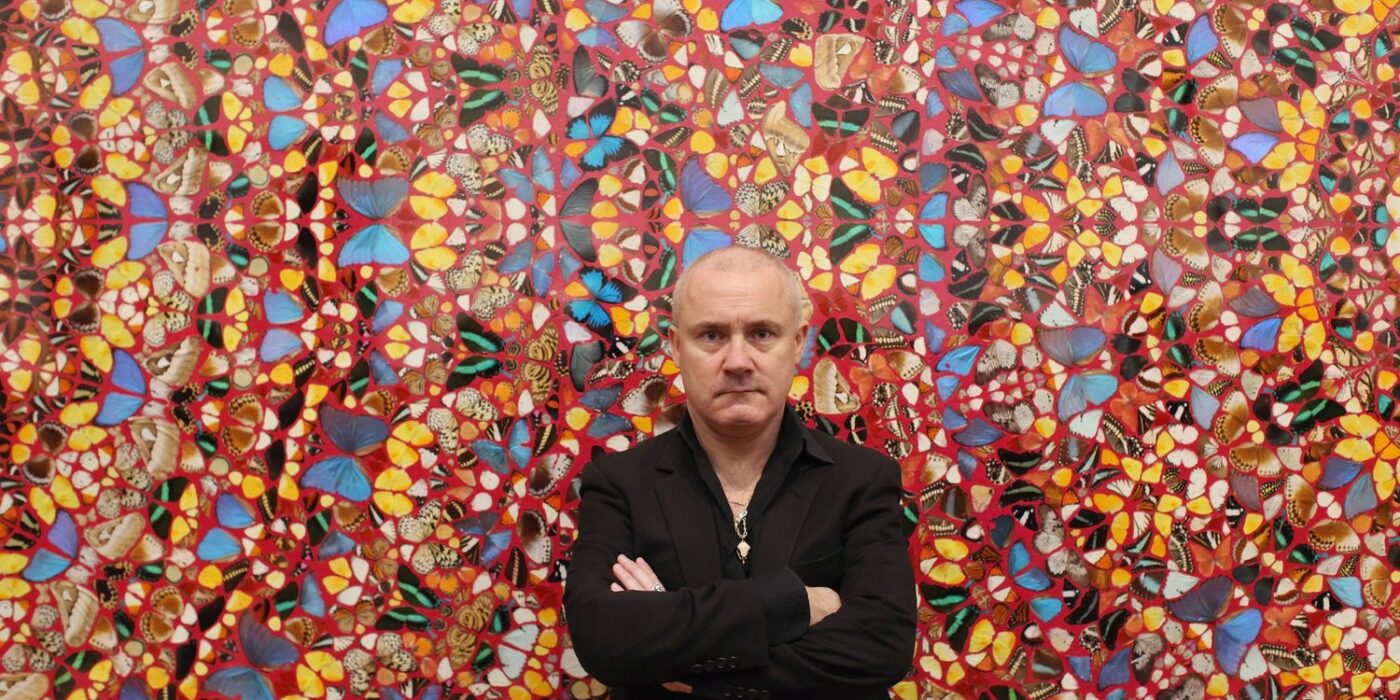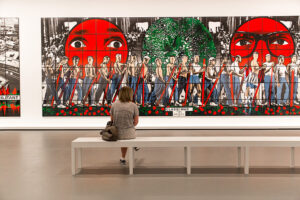Latest Art Movements You Should Know | Best Modern Styles
woman, modern art gallery, Paris
Contemporary art is always changing. In the past few decades, new art styles and forms have appeared. These movements are not just new trends. They’ve redefined what art can be by focusing on simplicity, ideas over materials, and new ways of interacting with the world and culture.
Staying up to date with these modern trends is important for any art lover. This article will introduce you to several key art movements. They started appearing in the late 1960s and early 1970s. Some of these include Minimalism, Conceptual Art, and the Young British Artists. You’ll also learn about Photorealism, Fluxus, and Land Art, among others.
Key Takeaways
- Contemporary art movements have evolved significantly since the late 1960s, showcasing a diverse range of styles and approaches.
- Minimalism and Conceptual Art emerged in the 1960s and 1970s, pioneering new ways of engaging with art and materials.
- Photorealism, Fluxus, and Land Art in the 1970s challenged traditional artistic boundaries and conventions.
- The Pictures Generation in the late 1970s and early 1980s focused on questioning the influence of mass media and visual culture.
- Neo-Expressionism in the 1980s marked a return to emotional and spontaneous artistic expression.
Cutting-Edge Trends in Contemporary Art
Today, artists are always trying new things in the art scene. They break from old ways and find fresh ways to create. Key trends that everyone is talking about are Minimalism, Conceptual Art, and Photorealism.
Minimalism: Embracing Simplicity and Geometry
Minimalism focuses on the very basics. It comes from late modernism and is all about simplicity. Artists use grids and simple shapes. Some famous minimalist artists are Donald Judd and Agnes Martin. They want people to see art as just objects, not something else.
Conceptual Art: Ideas Over Materials
Conceptual Art is all about the big ideas. It says art is more about the ideas behind it than the actual materials used. Sol LeWitt created big drawings on walls to show that. Joseph Kosuth played with codes to redefine art. These artists changed what people thought art was supposed to be.
Photorealism: Capturing Every Detail
Photorealism turned things around in the art world. Artists like Chuck Close tried to make paintings look just like photos. They focused on tiny details, like individual hairs. This art style made people wonder: “Is it a photo or a painting?”
Unconventional Expressions: Fluxus and Land Art
The experimental art movements of the 1970s brought a fresh take to creating art. Fluxus, one of these movements, changed how we see and experience art. Artists such as Joseph Beuys and Yoko Ono drove this movement. They believed art should focus on the moment and not on objects. They took a fun, open approach, using everyday items and actions. This helped blur the lines between different art types.
Fluxus: Tearing Apart Artistic Conventions
Fluxus started in the 1960s and quickly gained a global following. It mixed different art forms in an experimental way. George Maciunas kick-started Fluxus. Its goal was to make art less ‘high-brow’ and more fun for everyone. Chance and audience involvement were key in their art, making it a shared, ever-changing experience.
Although Fluxus artists had different interests and styles, they shared a common goal. They wanted to make art more connected and accessible. They aimed to overlap different types of art and media.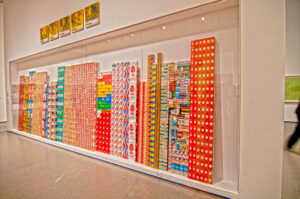 MoMA: One Year by George Maciunas
MoMA: One Year by George Maciunas
Land Art: Engaging with the Environment
At the same time, the Land Art movement was emerging. Artists in this movement worked directly in nature. They used performance, photography, and film, many times in remote areas. Robert Smithson, for example, made large-scale works that made us think about nature differently.
Both Fluxus and Land Art challenged traditional ideas of what art is. They showed that art doesn’t have to fit in only one category. Instead, it can be a mix of different forms, calling us to look at the world in new ways.
latest art movements you should know
The art world is always changing, and new styles have emerged in the last few decades. We’ve seen everything from Minimalism, focusing on simplicity and shape, to Conceptual Art, driven by ideas.1 With the rise of digital effects, Photorealism introduced a new way of creating art. The Fluxus movement brought performance and events into the art scene, marking a notable change.
Artists started engaging directly with nature through Land Art, while the Pictures Generation in New York began using photography and digital media in unique ways. Neo-Expressionism emerged in the 1980s as a response to the strict styles of the previous eras, focusing more on emotions and spontaneity. Text Art has also become an important form, with artists using text in creative and conceptual ways.
The Young British Artists (YBAs) have recently become known for their bold actions and innovative art, attracting global attention. It’s vital to keep up with the latest trends in art. New developments like NFTs and the reimagining of student housing as artwork present exciting opportunities for artists and art lovers to explore.
| Art Movement | Key Characteristics | Influential Artists |
|---|---|---|
| Minimalism | Simplicity, geometry, pristine surfaces | Donald Judd, Agnes Martin, Dan Flavin |
| Conceptual Art | Ideas and concepts over materials or processes | Sol LeWitt, Joseph Kosuth |
| Photorealism | Meticulous replication of photographs | Chuck Close |
| Fluxus | Challenging artistic conventions through performances, happenings, and events | Joseph Beuys, Yoko Ono |
| Land Art | Engaging directly with the natural environment | Robert Smithson |
| The Pictures Generation | Questioning the dominance of mass media and advertising | Cindy Sherman, Richard Prince |
| Neo-Expressionism | Embracing emotion and spontaneity in painting | Georg Baselitz |
| Text Art | Incorporating text as a visual and conceptual element | Martin Creed, David Shrigley, Jenny Holzer |
| The Young British Artists (YBAs) | Shock tactics and attention-grabbing actions | Tracey Emin, Damien Hirst |
The Pictures Generation: Questioning Visual Culture
In the late 1970s and early 1980s, the Pictures Generation started in New York. Artists like Cindy Sherman and Richard Prince used photos and digital images. They wanted to show how media and ads affect us, changing how we see ourselves and the world.
Cindy Sherman: Exploring Identity Through Photography
Cindy Sherman dove into photography around the late 1970s. She looked at the roles women play in society. Her pictures challenge stereotypes. They make us think about human intelligence and how we see things. Sherman’s goal is to spotlight how media shapes our identities.
Cindy Sherman | Untitled Film Still #21 | The Metropolitan Museum of Art
Richard Prince: Appropriating Mass Media
Richard Prince also worked with media images. He questioned the idea of original art. The Pictures Generation was big in the early 1980s, including the famous “Untitled Film Still” works by Sherman. It was part of a movement called “appropriation” and “simulationism.” This idea of using and changing known images showed the strong focus on consumerism and images at the time.
Neo-Expressionism: Embracing Emotion and Spontaneity
Neo-Expressionism started in the 1980s. It was a response to the very tidy styles of Minimalism and Photorealism. Artists such as Georg Baselitz mixed the messy look from the early 20th-century Expressionism. They also added realistic touches. This change was big for expressionist art. It let artists show more feelings and act freely in their art.
This style roots from abstract expressionism and early German Expressionism. Neo-Expressionism chose a rough, emotional way to art over the cool and distant looks of Minimalism and Photorealism. The art focused a lot on the artist’s touch: large brush movements, bright colors, and strong feelings rather than perfect details.
In Germany, Neo-Expressionism was key. Here, artists dealt with how Germany healed after the war. Artists like Baselitz and Anselm Kiefer made big, personal art. It showed the hard times they lived through.
Neo-Expressionism wasn’t just old-style Expressionism again. It changed things a lot. It was all about feelings, acting on the spot, and saying no to usual rules in art. These ideas fit with the big changes happening in the 1980s. Neo-Expressionism really shaped contemporary art.
Text Art: Integrating Words into Visual Expression
Text art has been key in art since the 1970s. Artists then started to mix words with images. This was new and showed how text could be art itself. It made people think and look closer at the art.
Martin Creed: Neon Signage and Soothing Messages
Martin Creed is a British artist known for simple, yet powerful works. He uses neon signs that say easy, comforting things. His art makes us feel something with very little words. One of his works, “Work No. 227: The lights going on and off,” is calming. It helps people think and feel in a quiet way.
David Shrigley: Witty Scribbles and Sketches
David Shrigley, from the UK, is another big name in text art. His work is funny, mixing words and silly pictures. He writes strange things that make us smile and think. His art is out of the ordinary, making us see the funny in everyday life. Shrigley’s work is made to amuse and surprise everyone while breaking the rules of traditional art.
Jenny Holzer: Light Art and Provocative Statements
Jenny Holzer, from the U.S., is famous for her light art with strong messages. She talks about power, who we are, and how society works. Her work makes us think deeply about these big ideas. By using text and light, she has become a leader in the text art world. Her work challenges and speaks to all of us.
Artists like Holzer, Shrigley, and Creed have shown us what text art can do. They mix words and images in new ways. This makes their art interesting and meaningful to look at and think about. They have opened new doors in art. Now, we see text in art as something that can be important and beautiful.
The Young British Artists: Shocking and Provoking
In the 1990s, a group of British artists took the art world by storm. They were the Young British Artists, or YBAs, famous for their bold moves and memorable actions. Key members like Tracey Emin and Damien Hirst shook up the scene with their daring and often controversial pieces, pushing the limits of modern art.
Tracey Emin: Turning the Mundane into Art
Among the YBAs, Tracey Emin stood out with her work that transformed ordinary life into art. Her artwork “My Bed” from 1998 made headlines. It showed her unmade bed in a gallery, complete with items like condoms and underwear. Another famous piece, “Everyone I Have Ever Slept With 1963 – 1995,” listed the names of 102 individuals she had slept with inside a tent.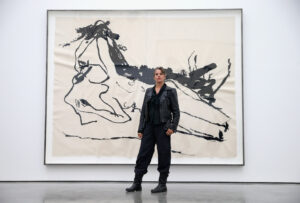 Artist Tracey Emin poses in front of her work as part of her “The Last Great Adventure is You” Exhibition at the White Cube Gallery
Artist Tracey Emin poses in front of her work as part of her “The Last Great Adventure is You” Exhibition at the White Cube Gallery
Damien Hirst: Challenging Perceptions with Controversial Work
Damien Hirst was also at the forefront of the YBA movement, known for his mind-bending pieces. One of his most famous works, “The Physical Impossibilities of Death In the Mind of Someone Living,” includes a shark in formaldehyde, dating back to 1991. This kind of shock art was a hallmark of the YBAs. They used animal remains, porn, and whatever they found to challenge what art could be.
The YBAs strove to change how we see and think about artwork. Today, their method still sparks deep conversations within contemporary art circles. Innovations like animal preservation, using everyday finds, and creating dynamic spaces have reshaped the art world. Their legacy endures, influencing current British art in significant ways.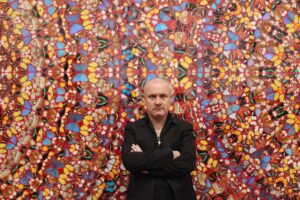
Contemporary Icon, Damien Hirst
Eco-Art and Toyism: Emerging Styles to Watch
In the art world, new movements are gaining attention – Eco-Art and Toyism. Critics and fans are interested. These styles bring new ideas to art, focusing on important topics today.
Eco-Art: Raising Environmental Awareness
Eco-Art, or Environmental Art, is using art to talk about the environment. It started getting popular in the 1960s and 1970s. It includes things like land art, eco-art, and large art projects. Artists in this field want to use their art to make people care more about the planet.
They want to encourage us to live more sustainably. Their work also aims to protect nature.
Toyism: Playful and Nostalgic Expressions
Toyism is all about joy and whimsy. It brings the fun and magical parts of toys and pop culture into art. This style is a fun change from the serious art of the past. Toyism artists love to make art that reminds us of happy times with toys.
They create art that is full of color and wonder. It makes people feel joyful and curious.
Both Eco-Art and Toyism show how art responds to new ideas and issues. They make the art world richer and more welcoming to different views.
Conclusion
The art world has changed a lot. There are new and bold movements that have shaped today’s art scene. From Minimalism’s simple approach to the big ideas of Conceptual Art, each style has something unique to offer. The art community keeps looking for new ways to express itself. This includes realistic art like Photorealism and experimental art such as Fluxus and Land Art.
The Pictures Generation, Neo-Expressionism, and the work of the Young British Artists show how art can reflect our world. These movements have adapted to our changing culture. Now, Eco-Art and Toyism bring environmental awareness and fun elements into art. They show new ways to think about the world around us.
Looking at the many contemporary art trends and innovative art styles we’ve discussed, I see the influence of art. It can inspire us, challenge our views, and bring communities together. By keeping up with the latest art movements, we learn more about the impact of these cutting-edge art forms.
FAQ
What are the latest art movements that have emerged in the contemporary art scene?
Since the late 1960s, new artistic styles have emerged. These include Minimalism, Conceptual Art, Photorealism, and more. Each of these movements brings fresh ideas and ways of creating art.
What is Minimalism and how does it differ from traditional art?
Minimalism is about keeping art simple and pure. It focuses on basic shapes and clean, perfect surfaces. Artists present art as objects for the viewer to appreciate.
How does Conceptual Art differ from traditional art forms?
Conceptual art is all about the ideas. It’s not just about the materials used. Artists like Sol LeWitt use wall drawings to explore these new concepts.
What is Photorealism and how does it mark a transition in art?
Photorealism started a new era by making art look like photos. For example, artists would paint details like hairs and pores. It brought a whole new level of realism into the art world.
What is Fluxus and how did it challenge artistic conventions?
Fluxus was a bold movement that challenged traditional art forms. Artists like Yoko Ono believed art should be about the experience, not just about objects. They changed how people think about art.
What is Land Art and how did it explore our relationship with the natural world?
Land Art explored nature through performance and art in natural settings. Artists did things like huge earthworks to show our connection with the earth. This took art out of galleries and into the environment.
What is the Pictures Generation and how did it question the dominance of mass media and advertising?
The Pictures Generation used imagery to question mass media’s influence. Artists like Cindy Sherman used photography to examine how media shapes our views. It made people think about the power of images.
What is Neo-Expressionism and how did it mark an important moment in the development of contemporary art?
Neo-Expressionism was a reaction against minimalist art styles. It focused on emotion and real-world subjects. This brought a more heartfelt and spontaneous feel to art.
How have artists used text as a visual and conceptual element in contemporary art?
Text has been a key part of art since the 1970s. Artists use it to express ideas or add visual interest. For example, Jenny Holzer uses texts and lights for powerful statements.
What is the Young British Artists (YBAs) movement and how have they influenced the contemporary art scene?
The Young British Artists shook up the art world in the 1990s. Their bold and sometimes shocking works caught global attention. They continue to challenge and change the art scene.
What are Eco-Art and Toyism, and how are they emerging in the contemporary art landscape?
Eco-Art raises awareness about nature and the environment. Toyism, in contrast, is whimsical and draws on pop art and childhood. Both are finding a place in today’s art world.
